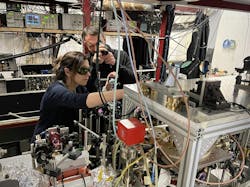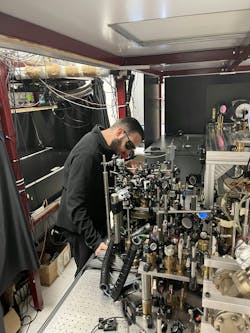A team of researchers in Italy recently discovered that a mixture of ultracold gases shaped into a filament breaks up akin to a jet of water into multiple droplets, thanks to surface tension. Droplets formed from quantum gases—quantum droplets—are tiny clusters of atoms with liquid-like properties whose stability is ensured by quantum effects. They call the formation of a sequence of these droplets “quantum rain.”
The experimental work was led by Alessia Burchianti and Luca Cavicchioli of Italy’s National Research Council’s (CNR) Quantum Mixtures Lab of the National Institute of Optics (INO), and includes researchers at the University of Florence, the European Laboratory for Nonlinear Spectroscopy, the University of Bologna, University of Padua, and the University of the Basque Country in Spain (see video).
During the past few years, scientists managed to create quantum droplets by manipulating different systems of ultracold atoms. Within this context, breakthrough experiments demonstrated that a two-component ultracold gas—formed by two atomic states or species—can collapse in a single quantum droplet. Like a raindrop, a quantum droplet doesn’t expand within free space and this preserves its size and shape.
“Inspired by these pioneering studies and fascinated by the peculiar-but-elusive properties of this novel state of matter, we decided to explore the physics of quantum droplets,” says Burchianti. “Our initial idea was to study the dynamics of a droplet created out of equilibrium and released into an optical waveguide. We couldn’t have imagined that this droplet—stretched along the waveguide—would break up into an array of subdroplets due to capillary instability, a common phenomenon in liquids but not yet observed for ultracold gases.”
Quantum droplet formation
The team’s experimental setup relies on an ultrahigh vacuum system to isolate the atomic gas from the surrounding environment, along with several laser systems designed to precisely manipulate and probe the atoms. Their apparatus also includes numerous optical components, charged-coupled device (CCD) cameras for imaging, magnetic coils for magnetic field generation, and various instruments essential for measurement and control.
They use standard laser and evaporative cooling techniques to cool a gas mixture of potassium-41 and rubidium-87 to ultralow temperatures, just a few billionths of a degree above absolute zero. “The gas is spatially confined using optical traps formed by focused laser beams,” says Cavicchioli. “We apply a magnetic field to exploit a Feshbach resonance, which is a quantum effect that allows us to control how strongly atoms attract or repel each other. Finally, we use a high-resolution optical microscope to observe the density distribution of atoms—this imaging system is sensitive enough to resolve tiny, micrometer-sized objects like quantum droplets.”
The team’s method starts out by producing a noninteracting ultracold mixture that contains approximately half a million atoms. “A sudden change of the magnetic field drives the system into the strongly attractive regime—where a quantum droplet forms,” explains Cavicchioli. “This droplet is released into a laser-beam-generated waveguide, where it undergoes a compression/elongation motion mainly along the guide.”
By following the system’s dynamics, “an instability sets in once the droplet expands beyond a critical length,” he says. “The droplet/filament eventually breaks up into smaller droplets whose number is determined by the filament’s length at the time of breakup. By combining theory and experiment, we showed that this behavior we observed is consistent with capillary instability, a.k.a. Plateau-Rayleigh instability, and it causes the breakage of the stretching droplet due to the surface tension.”
One of the most surprising moments during this work hit when what the team initially thought was a stretched droplet revealed itself under the microscope to be a chain of individual droplets. “This phenomenon had already been theoretically predicted for an ideal quantum filament composed of potassium-41 and rubidium-87, but we never expected to observe it within our complex experimental conditions,” says Cavicchioli.
Another “aha!” moment occurred during data analysis. “When we plotted the results, we saw that the number of droplets formed matched the predictions of the Plateau-Rayleigh model—originally developed for an inviscid (no or negligible viscosity) classical fluid,” he adds. “Being able to describe the observed phenomenon with a simple model that captured the underlying mechanisms was a particularly satisfying outcome.”
What does the team’s work mean for quantum materials, liquids, and gases? “Quantum droplets are ultradilute atomic systems held together solely by contact interactions,” says Burchianti. “It may seem surprising that they behave like water draining from a faucet. But these self-bound states are characterized by a surface tension just like water, although it arises from a fundamentally different mechanism. This surface tension is what drives the capillary instability we observe and leads the initial droplet to break up into smaller droplets to minimize the surface area.”
Their results provide a deeper understanding of the liquid-like behavior of quantum droplets and enrich the range of hydrodynamic instabilities observed within ultracold gases—drawing an analogy with classical fluids. “Our platform opens a pathway to create arrays of quantum droplets to explore their unique properties—with potential applications for quantum technologies,” she says.
Challenges along the way
A large number of atoms and a highly sensitive imaging system are key aspects of the team’s setup—and these are challenging goals researchers must pull off for many ultracold gases experiments.
“We’ve optimized all phases of the complex sequence used to produce the ultracold mixture and substantially improved the atom number for both atomic species,” says Cavicchioli.
At the same time, they developed a custom high-resolution microscope to image the atoms. “Although optical objectives with micrometric resolution are standard tools, integrating them into an existing setup is far from trivial,” he says. “Furthermore, the experiment requires a high degree of stability: Optical systems are extremely sensitive to temperature fluctuations and even small misalignments can compromise the repeatability of the experiment. This remains one of the major challenges we’re actively working to address.”
Interferometry applications on the horizon?
The physics of quantum droplets is within its infancy and many of their properties remain unexplored. Practical applications aren’t likely immediate, but “based on prior experience with quantum gases it’s possible to imagine future directions,” says Burchianti.
“Quantum droplets are of interest for interferometry, for example,” she points out. “Ultracold atom interferometers typically operate with samples in freefall, during which the sample size increases and leads to reduced signal strength. External confinement can be used to preserve the sample size—but it also introduces instabilities into the confining potential. Self-bound coherent samples that don’t expand during freefall would offer clear advantages for such setups.”
Quantum droplets are natural candidates within this context, although their short lifetime— typically of the order of several tens of milliseconds—currently represents a major limitation for applications. “Nevertheless, efforts to control and reduce the three-body inelastic collisions responsible for this short lifetime are actively ongoing in several experiments, which suggests the droplet lifetime can be substantially increased in the future,” Burchianti says.
Superfluid and coherence properties
What’s ahead? Next, the team plans to explore the superfluid and coherence properties of quantum droplets. “These states, much like Bose-Einstein condensates, are expected to behave as coherent matter waves,” says Burchianti. “Each droplet can be described by a macroscopic wavefunction with a well-defined phase, which is a property closely linked to its superfluidic nature. As a result, interference phenomena may emerge when two or more droplets merge. The possibility of detecting interference patterns from multiple quantum droplets represents a crucial step toward understanding the coherence of the system as a whole. In analogy with extensive research about dipolar gases, this could lay the foundation for exploring more exotic phenomenon such as supersolidity.”
Another promising direction is the creation of droplets in reduced dimensionality or within curved geometries. “These configurations could significantly alter their properties and potentially reduce the impact of inelastic collisions—and extend their lifetime,” says Burchianti.
FURTHER READING
L. Cavicchioli et al., Phys. Rev. Lett., 134, 093401 (Mar. 7, 2025); https://doi.org/10.1103/physrevlett.134.093401.
About the Author
Sally Cole Johnson
Editor in Chief
Sally Cole Johnson, Laser Focus World’s editor in chief, is a science and technology journalist who specializes in physics and semiconductors.



